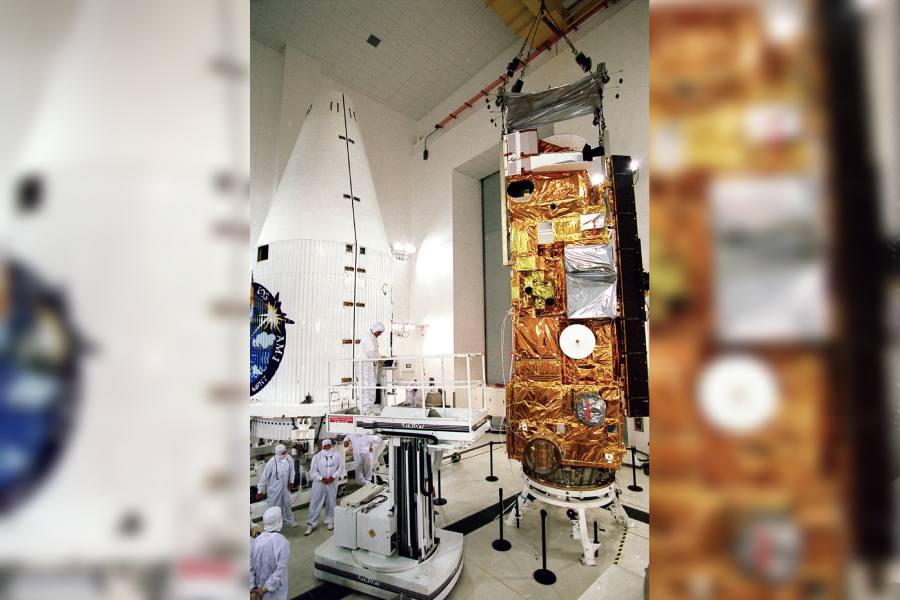Sometime in the next few years — no one knows exactly when — three NASA satellites, each one as heavy as an elephant, will go dark.
Already they are drifting, losing height bit by bit. They have been gazing down at the planet for over two decades, far longer than anyone expected, helping us forecast the weather, manage wildfires, monitor oil spills and more. But age is catching up to them, and soon they will send their last transmissions and begin their slow, final fall to Earth.
It’s a moment scientists are dreading.
When the three orbiters — Terra, Aqua and Aura — are powered down, much of the data they’ve been collecting will end with them, and newer satellites won’t pick up all of the slack. Researchers will either have to rely on alternate sources that might not meet their exact needs or seek workarounds to allow their records to continue.
With some of the data these satellites gather, the situation is even worse: No other instruments will keep collecting it. In a few short years, the fine features they reveal about our world will become much fuzzier.

In an image provided by KSC/NASA, the Terra spacecraft in a clean room at Vandenberg Air Force Base, Calif., on Nov. 18, 1999. KSC/NASA via The New York Times
“Losing this irreplaceable data is simply tragic,” said Susan Solomon, an atmospheric chemist at the Massachusetts Institute of Technology. “Just when the planet most needs for us to focus on understanding how we are affected by it, and how we are affecting it, we seem to be disastrously asleep at the wheel.”
The main area we’re losing eyes on is the stratosphere, the all-important home of the ozone layer.
Across the stratosphere’s cold, thin air, ozone molecules are constantly being formed and destroyed, tossed and swept, as they interact with other gases. Some of these gases have natural origins; others are there because of us.
An instrument on Aura, the microwave limb sounder, gives us our best line of sight into this seething chemical drama, said Ross J. Salawitch, an atmospheric scientist at the University of Maryland. Once Aura is gone, our vision will dim considerably, he said.
Recently, data from the microwave limb sounder has been proving its worth in unexpected ways, Salawitch said. It showed how much damage was done to ozone by the devastating wildfires in Australia in late 2019 and early 2020, and by the undersea volcanic eruption near Tonga in 2022. It helped show how much ozone-depleting pollution was getting lofted into the stratosphere over East Asia by the region’s summer monsoon.

In an image provided by KSC/NASA, a team prepares Aqua satellite for launch at Vandenberg Air Force Base, Calif., on March 1, 2002 KSC/NASA via The New York Times
If it weren’t going offline so soon, the sounder might also help unravel a big mystery, Salawitch said. “The thickness of the ozone layer over populated regions in the Northern Hemisphere has hardly changed over the last decade,” he said. “It should be recovering. And it’s not.”
Jack Kaye, the associate director of research at NASA’s Earth Science Division, acknowledged researchers’ concerns about the end of the sounder. But he argued that other sources, including instruments on newer satellites, on the International Space Station and here on Earth, would still provide “a pretty good window into what the atmosphere is doing.”
Financial realities force NASA to make “tough decisions,” Kaye said. “Would it be great to have everything last forever? Yeah,” he said. But part of NASA’s mission is also to offer scientists new tools, ones that help them look at our world in new ways, he said. “It’s not the same, but, you know, if not everything can be the same, you do the best that you can,” he said.
Last year, NASA canvassed scientists for thoughts on how the end of Terra, Aqua and Aura would affect their work. More than 180 of them answered the call.
In their letters, which The New York Times obtained through a Freedom of Information Act request, the researchers voiced worries about a wide range of data from the satellites. Information about the particles in wildfire smoke, desert dust and volcanic plumes. Measurements of the thickness of clouds. Fine-scale maps of the world’s forests, grasslands, wetlands and crops.

An undated satellite image provided by NASA Earth Observatory and captured by the Terra satellite shows the collapse of the Larsen B Ice Shelf in Antarctica NASA Earth Observatory via The New York Times
Even if there are alternate sources for this information, the scientists wrote, they might be less frequent, or lower resolution, or limited to certain times of day, all factors that shape how useful the data is.
The end of Terra and Aqua will affect the way we monitor another important driver of our climate: how much solar radiation the planet receives, absorbs and bounces back to space. The balance between these amounts — or, really, the imbalance — determines how much Earth warms or cools. And to understand it, scientists rely on the instruments of NASA’s Clouds and the Earth’s Radiant Energy System, or CERES.
Right now, four satellites are flying with CERES instruments: Terra, Aqua, plus two newer ones that are also nearing their end. Yet only one replacement is in the works. Its life expectancy? Five years.
“Within the next 10 years, we’re going to go from four missions down to one, and the one remaining will be past its prime,” said Norman G. Loeb, the NASA scientist who leads CERES. “To me, that’s really sobering.”
These days, with the rise of the private space industry and the proliferation of satellites around Earth, NASA and other agencies are exploring a different approach to keeping eyes on our planet. The future may lie with smaller, lighter instruments, ones that could be put into orbit more cheaply and nimbly than Terra, Aqua and Aura were back in their day.

In an undated satellite image provided by NASA/GSFC/LaRC/JPL, MISR Team, Marine stratocumulus clouds over the southeastern Pacific Ocean, captured by NASA’s Terra satellite in 2002 NASA/GSFC/LaRC/JPL, MISR Team via The New York Times
The National Oceanic and Atmospheric Administration is developing such a fleet for monitoring weather and climate. Loeb and others at NASA are working on a lightweight instrument for continuing their measurements of Earth’s energy balance.
But for such technologies to be useful, Loeb said, they have to start flying before today’s orbiters go dark.
“You need a good, long period of overlap to understand the differences, work out the kinks,” he said. “If not, then it’s going to be really difficult to have trust in these measurements, if we haven’t had a chance to prove them against the current measurements.”
The New York Times News Service











